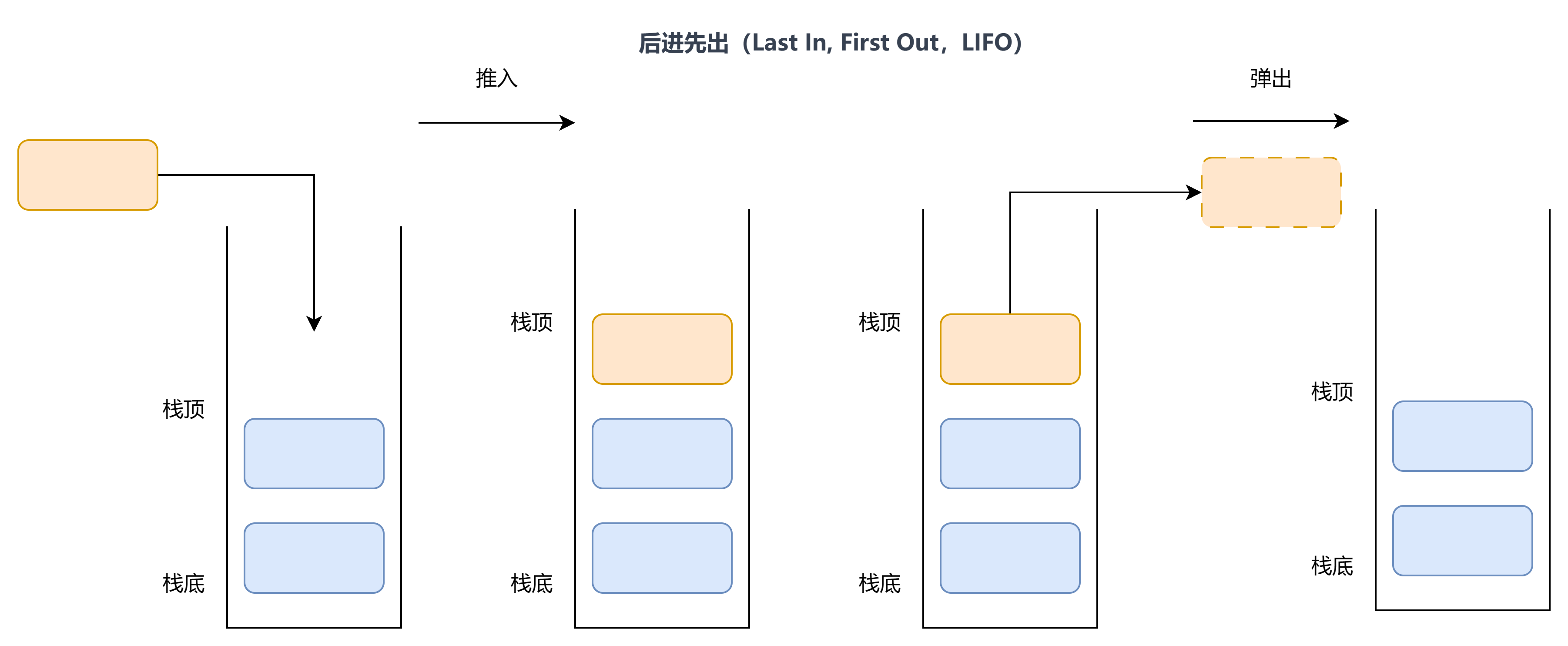【数据结构】栈和队列

前言:
栈(Stack)和队列(Queue),它们都是常用的数据结构,用于组织和存储数据。
一、栈
当我们谈论栈时,我们实际上在谈论一种后进先出(Last In, First Out,LIFO)的数据结构。这意味着最后插入的元素首先被移除。让我们深入了解一下栈的特性和操作:
1. 特性:
-
后进先出(LIFO): 最后放入栈的元素是第一个被移除的。
-
操作受限: 栈有两个主要操作:推入(Push)和弹出(Pop)。推入将元素添加到栈的顶部,而弹出则将栈顶的元素移除。
-
栈顶: 只有栈顶的元素是可见的,即只能访问或修改栈顶的元素。
2. 操作:
-
推入(Push): 将元素添加到栈的顶部。
-
弹出(Pop): 从栈的顶部移除元素。
-
查看栈顶(Peek): 查看栈顶的元素,但不移除它。
-
判空和判满: 可以检查栈是否为空(Empty)或已满(Full),虽然栈的大小通常是动态调整的,因此满的情况相对较少。

栈的实现
栈的实现一般可以使用数组或者链表实现,相对而言数组的结构实现更优一些。这里我们使用动态的数组来实现栈。

Stack 结构体:
typedef int STDataType;
typedef struct Stack {
STDataType* a;
int top; //标识栈顶
int capacity; //容量
}ST;
操作栈的函数:
//初始化
void StackInit(ST* pst);
//销毁栈
void StackDestroy(ST* pst);
//栈顶推入
void StackPush(ST* pst, STDataType x);
//栈顶弹出
void StackPop(ST* pst);
//获取栈顶元素
STDataType StackTop(ST* pst);
//检测栈是否为空
bool StackEmpty(ST* pst);
//获取栈的有效元素个数
int StackSize(ST* pst);
完整的栈的代码在最后
二、队列
队列(Queue)是一种基本的数据结构,它遵循先进先出(First In, First Out,FIFO)的原则。这意味着最先进入队列的元素将最先被移出,就像排队一样。队列常被用于需要按顺序处理的场景,比如任务调度、广度优先搜索、打印任务等。
以下是队列的一些关键特性和基本操作:
1. 特性:
-
先进先出(FIFO): 队列中最早进入的元素首先被移除。
-
操作受限: 队列主要支持两个操作:入队(Enqueue)和出队(Dequeue)。
-
队头和队尾: 队列的前端称为队头(Front),用于出队操作;队列的后端称为队尾(Rear),用于入队操作。
2. 操作:
-
入队(Enqueue): 向队尾添加元素。
-
出队(Dequeue): 从队头移除元素。
-
查看队头元素(Front): 查看队头的元素,但不移除它。
-
检查队列是否为空: 判断队列中是否有元素。
-
检查队列是否已满(对于有限队列): 在使用有限大小的队列时,可以检查队列是否已满。
在实际编程中,队列可以使用数组、链表或其他数据结构来实现。例如,使用数组时需要考虑队列的大小和溢出的问题,而使用链表时可以更方便地处理动态大小的队列。

队列的实现
队列也可以数组和链表的结构实现,使用链表的结构实现更优一些,因为如果使用数组的结构,出队列在数组头上出数据,效率会比较低。

Queue结构体
typedef int QDataType;
//节点
typedef struct QueueNode {
QDataType val;
struct QueueNode* next;
}QNode;
typedef struct Queue {
QNode* phead;//队头节点
QNode* ptail;//队尾节点
int size; //元素长度
}Queue;
操作函数
//初始化
void QueueInit(Queue* pq);
//销毁队列
void QueueDestroy(Queue* pq);
//插入
void QueuePush(Queue* pq, QDataType x);
//弹出
void QueuePop(Queue* pq);
//队头
QDataType QueueFront(Queue* pq);
//队尾
QDataType QueueBack(Queue* pq);
//队列是否为空
bool QueueEmpty(Queue* pq);
//队列元素个数
int QueueSize(Queue* pq);
附录
栈实现的完整代码
“Stack.h”
#pragma once
#include<stdio.h>
#include<stdlib.h>
#include<assert.h>
#include<stdbool.h>
typedef int STDataType;
typedef struct Stack {
STDataType* a;
int top; //标识栈顶
int capacity; //容量
}ST;
//初始化
void StackInit(ST* pst);
//销毁栈
void StackDestroy(ST* pst);
//栈顶推入
void StackPush(ST* pst, STDataType x);
//栈顶弹出
void StackPop(ST* pst);
//获取栈顶元素
STDataType StackTop(ST* pst);
//检测栈是否为空
bool StackEmpty(ST* pst);
//获取栈的有效元素个数
int StackSize(ST* pst);
“Stack.c”
#include"Stack.h"
void StackInit(ST* pst) {
assert(pst);
pst->a = NULL;
pst->capacity = 0;
pst->top = 0;//指向栈顶下一个元素
}
void StackDestroy(ST* pst) {
assert(pst);
free(pst->a);
}
void StackPush(ST* pst, STDataType x) {
assert(pst);
if (pst->top == pst->capacity) {
int newcapacity = pst->capacity = 0 ? 4 : 2 * pst->capacity;
STDataType* temp = realloc(pst->a,sizeof(STDataType)*newcapacity);
if (temp == NULL) {
perror("realloc fail");
return;
}
pst->a = temp;
pst->capacity = newcapacity;
}
pst->a[pst->top] = x;
pst->top++;
}
void StackPop(ST* pst) {
assert(pst);
//不为空
assert(pst->top > 0);
pst->top--;
}
STDataType StackTop(ST* pst) {
assert(pst);
//不为空
assert(pst->top > 0);
return pst->a[pst->top - 1];
}
bool StackEmpty(ST* pst) {
assert(pst);
return pst->top == 0;
}
int StackSize(ST* pst) {
assert(pst);
return pst->top;
}
“test.c”
#include"Stack.h"
int main() {
ST s;
StackInit(&s);
StackPush(&s,1);
StackPush(&s,2);
StackPush(&s,3);
printf("%d ", StackTop(&s));
StackPush(&s, 4);
printf("%d ", StackTop(&s));
while (!StackEmpty(&s)) {
printf("%d ", StackTop(&s));
StackPop(&s);
}
return 0;
}
队列实现的完整代码
“Queue.h”
#pragma once
#include<stdio.h>
#include<assert.h>
#include<stdlib.h>
#include<stdbool.h>
typedef int QDataType;
//节点
typedef struct QueueNode {
QDataType val;
struct QueueNode* next;
}QNode;
typedef struct Queue {
QNode* phead;//队头节点
QNode* ptail;//队尾节点
int size; //元素长度
}Queue;
//初始化
void QueueInit(Queue* pq);
//销毁队列
void QueueDestroy(Queue* pq);
//插入
void QueuePush(Queue* pq, QDataType x);
//弹出
void QueuePop(Queue* pq);
//队头
QDataType QueueFront(Queue* pq);
//队尾
QDataType QueueBack(Queue* pq);
//队列是否为空
bool QueueEmpty(Queue* pq);
//队列元素个数
int QueueSize(Queue* pq);
“Queue.c”
#include "Queue.h"
void QueueInit(Queue*pq) {
assert(pq);
pq->phead = pq->ptail = NULL;
pq->size = 0;
}
void QueueDestroy(Queue* pq) {
assert(pq);
QNode* cur = pq->phead;
while (cur) {
QNode* next = cur->next;
free(cur);
cur = next;
}
pq->phead = pq->ptail = NULL;
pq->size = 0;
}
void QueuePush(Queue* pq, QDataType x) {
assert(pq);
QNode* newnode = (QNode* )malloc(sizeof(QNode));
if (newnode == NULL) {
perror("malloc fail");
return;
}
newnode->val = x;
newnode->next = NULL;
if (pq->ptail == NULL) {
pq->ptail = pq->phead = newnode;
}
else {
pq->ptail->next = newnode;
pq->ptail = newnode;
}
pq->size++;
}
void QueuePop(Queue* pq) {
assert(pq->phead);
assert(pq);
QNode* del = pq->phead;
pq->phead = pq->phead->next;
free(del);
del = NULL;
if (pq->phead == NULL)
pq->ptail = NULL;
pq->size--;
}
QDataType QueueFront(Queue* pq) {
assert(pq);
assert(pq->phead);
return pq->phead->val;
}
QDataType QueueBack(Queue* pq) {
assert(pq);
assert(pq->ptail);
return pq->ptail->val;
}
bool QueueEmpty(Queue* pq) {
assert(pq);
return pq->phead == NULL;
}
int QueueSize(Queue* pq) {
assert(pq);
return pq->size;
}
“test.c”
#include"Queue.h"
int main() {
Queue q;
QueueInit(&q);
QueuePush(&q,1);
QueuePush(&q,2);
QueuePush(&q,3);
QueuePush(&q,4);
QueuePush(&q,5);
while (!QueueEmpty(&q)) {
printf("%d",QueueFront(&q));
QueuePop(&q);
}
}

如果你喜欢这篇文章,点赞👍+评论+关注??哦!
欢迎大家提出疑问,以及不同的见解。
本文来自互联网用户投稿,该文观点仅代表作者本人,不代表本站立场。本站仅提供信息存储空间服务,不拥有所有权,不承担相关法律责任。 如若内容造成侵权/违法违规/事实不符,请联系我的编程经验分享网邮箱:chenni525@qq.com进行投诉反馈,一经查实,立即删除!
- Python教程
- 深入理解 MySQL 中的 HAVING 关键字和聚合函数
- Qt之QChar编码(1)
- MyBatis入门基础篇
- 用Python脚本实现FFmpeg批量转换
- Reactor和Proactor两种高效的事件处理模式
- 全网最全pytest大型攻略,单元测试学这就够了!
- 配电室智能监控系统设计及实现分析——安科瑞赵嘉敏
- 2023“SEED”第四届江苏大数据--新能源赛道 复赛Btop2总结
- 联易融携手渣打银行:落地首笔可持续挂钩深层供应链融资项目
- 【USTC】verilog 习题练习1-5
- uView Subsection 分段器
- VCG 曲面重建之滚球算法
- 关掉RHEL 8安装软件包订阅注册
- 理解“面向对象编程”概念